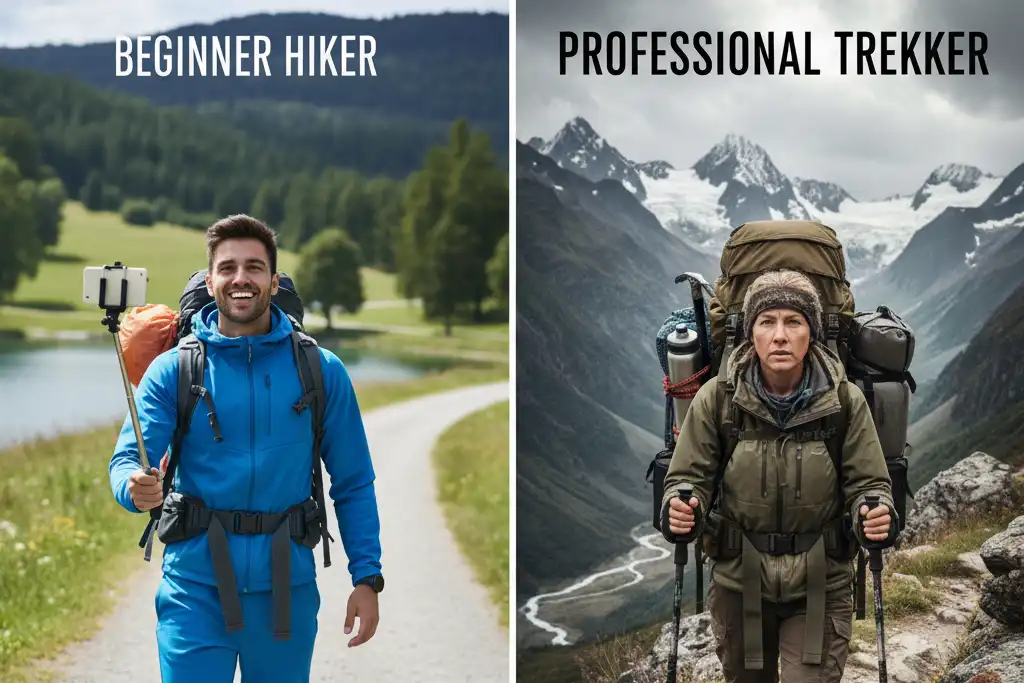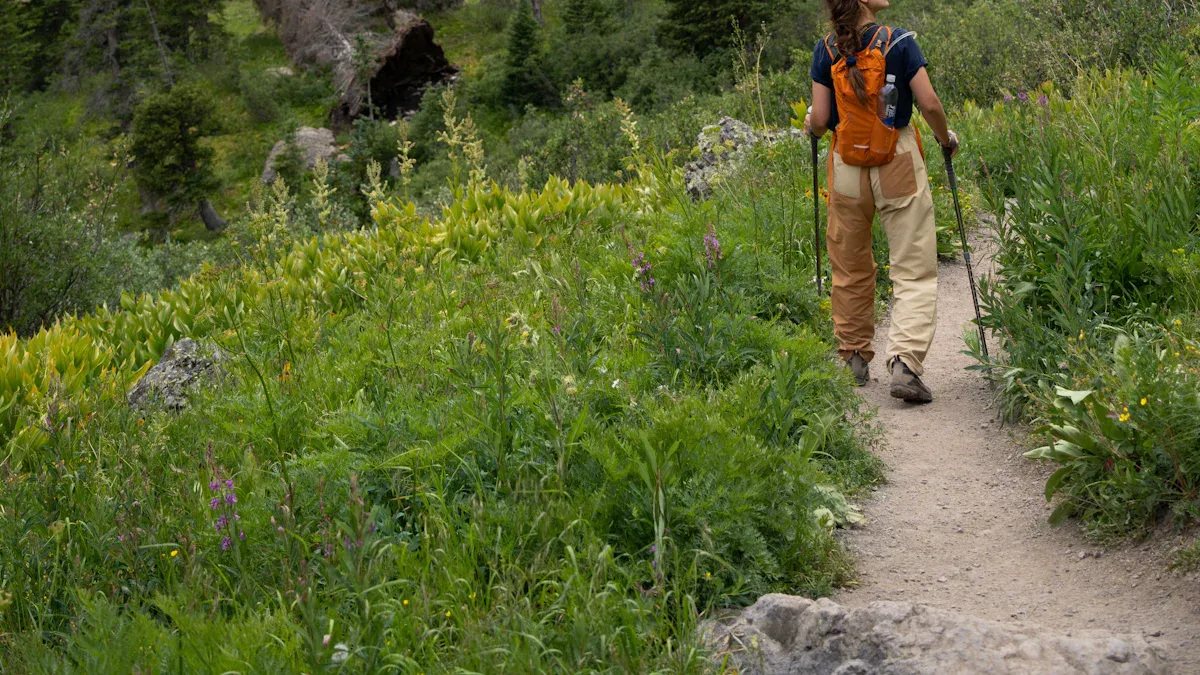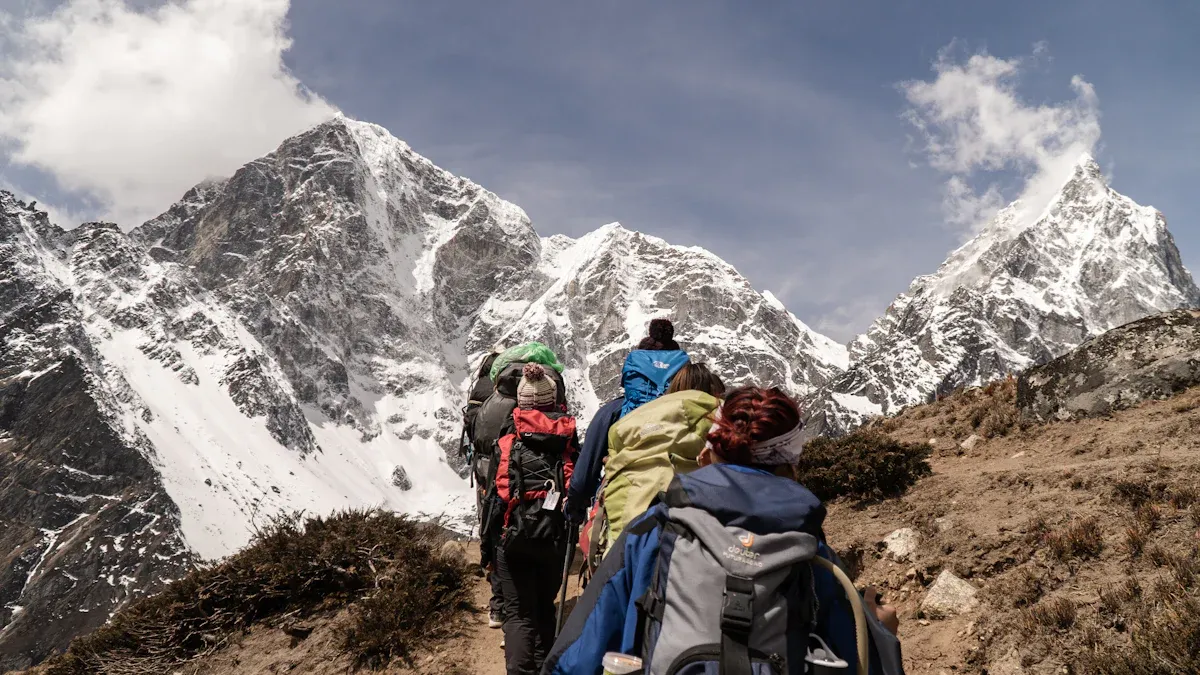What Is a Suitable Daily Hiking Distance for Beginners and Pros

Are you thinking about how far you should hike each day? Most beginners feel good with 8 to 10 miles. If you are pretty fit, you might do 8 to 12 miles. People with lots of hiking experience often go 15 to 30 miles or more. The best daily distance for you depends on things like your fitness, your hiking experience, the land, and the weather. Look at this table to see how your fitness level can change how far you hike:
| Fitness Level | Daily Limits (Distance/Vertical Gain) | Impact on Hiking Speed and Breaks |
|---|---|---|
| Basic | Lower limits | Slower speed, longer breaks |
| Moderate | Moderate limits | Average speed, average breaks |
| Median | Balanced limits | Consistent speed, fewer breaks |
| High | Higher limits | Faster speed, shorter breaks |
| Ultra | Maximum limits | Fastest speed, minimal breaks |
- People who are fitter can hike more miles and climb higher.
- Hard trails and bad weather can make you slower.
You should pay attention to your body. Try to hike a little more each time. Always make sure you stay safe.
Key Takeaways
- Beginners should hike 2 to 5 miles on easy trails. You can hike longer as you get stronger and more confident.
- Your fitness and experience decide how far you can hike. Strong hikers can walk 8 to 30 miles each day. This depends on the trail and weather.
- Pacing is very important. Start slow and take breaks often. Listen to your body so you do not get too tired. This helps you enjoy hiking more.
- Weather and gear change your hiking trip. Wear the right clothes and good shoes. This keeps you safe and comfortable.
- Safety comes first. Know what you can do and get ready for emergencies. Try to hike with a friend if you can.
Hiking Distance Factors
Fitness and Experience
How fit you are and how much you hike matters a lot. If you are new, you may get tired fast. When you hike more, you can go farther. Many hikers like to set goals for themselves. They enjoy seeing how far they can go. Your health also affects how far you can hike. Being with friends and loving nature helps you keep going. Experts say these things change how far you hike:
- Wanting to challenge yourself
- Health and how you feel now
- Talking with other hikers
- Feeling happy in nature
- Trying to reach distance goals
You can look at the table to see how fitness tests show hiking ability:
| Fitness Test | Trail Type | Predictive Ability |
|---|---|---|
| Step-up Test | Easy | Best predictor of mean and maximum HR |
| Step-up Test + Cooper Test | Moderate | Best predictor of mean HR |
If you have hiked a lot, you can go farther. For example, one hiker in Australia walked over 31 km each day. This shows that experience helps you hike more.
Terrain and Elevation
The ground and how high you climb change your speed and distance. Walking up hills or on rocks takes more work. High places have less oxygen, so you get tired faster. You may need to rest more or get used to the height. These things can slow you down:
- Climbing uses more energy
- Less oxygen makes you tired
- Altitude sickness slows you down
- Steep or loose ground is harder
- Rocky and muddy paths need care
- Winding trails take more time
Check the table to see how ground and height change speed:
| Hiking Profile | Cruising Speed (mph) | Notes |
|---|---|---|
| 35-year-old athletic male | 3.5 – 4 | Varied elevation |
| Shorter, casual pace female | 2.5 – 3 | Pushing at 3 – 3.5 mph |
| General estimate | 30 min/mile | 30 min/1000′ climbing |
| Naismith’s formula | Adjusted for terrain | Slick trail adds 50%, bushwacks add 100% |
Tip: Try tracking your speed with your gear on the same kind of trail before a big hike.
How much your pack weighs also matters. Heavy packs make you slower and you walk less each day. For example:
| Pack Weight (lbs) | Hiking Pace (mph) | Estimated Daily Mileage (miles) |
|---|---|---|
| 12-25 | 3.2 | 44.8 |
| 12-25 | 3.7 | 59.2 |
Weather and Gear
Weather and gear can change your hike quickly. If you wear the right clothes, you stay safe and comfy. Good shoes and clothes help you walk farther without hurting. Always be ready for sudden weather changes. Experts say good gear and clothes are very important. If you get stuck in rain or cold without gear, you may need to stop early. The right gear makes hiking fun and helps you go farther.
- Good clothes keep you safe and comfy
- Be ready for sudden weather changes
- Good shoes and gear help you hike more
Hiking for Beginners

Starting Distances
When you first start hiking, you might wonder what distance feels right. Most outdoor groups suggest you begin with easy trails that are less than 5 miles long. These trails usually have little elevation gain and let you get used to walking on uneven ground. Many beginners feel comfortable hiking between 2 to 5 miles in a day, depending on how fit you are and how tough the trail looks.
- Choose a trail that matches your current fitness.
- Start with shorter hikes and add more distance as you gain confidence.
- Pick routes with gentle slopes and clear paths.
Tip: You do not need to push yourself to the limit on your first hike. Enjoy the scenery and focus on building your skills.
If you feel strong after a few hikes, you can try going up to 8 miles. Increase your distance slowly. This helps your body adjust and keeps hiking fun.
Pacing and Rest
Pacing matters a lot when you hike. You want to find a speed that feels easy and lets you keep going for hours. Start at a slow, steady pace. You can always speed up later if you feel good. Your pace might change with the trail or how you feel that day.
- Listen to your body and slow down if you feel tired.
- Take short breaks often, especially on hills.
- Practice breathing through your nose to stay calm and save energy.
- Try to keep your steps even and avoid rushing.
A good pace helps you finish your hike without feeling worn out. Resting often gives your muscles time to recover. You will enjoy hiking more if you do not rush.
Safety Tips
Safety should always come first when you hike. You want to know the trail and what to expect before you go. Check maps and read about the trail conditions. Pick hikes that match your fitness and skill level.
- Learn about the trail and weather before you leave.
- Know your limits and choose hikes you can finish.
- Bring enough water, snacks, and a small first aid kit.
- Hike with a friend or tell someone where you are going.
- Carry a phone or map in case you get lost.
Note: Always have a plan for emergencies. It is better to be prepared than to get caught off guard.
Hiking with others makes the trip safer and more fun. If you follow these tips, you will build confidence and enjoy every step on the trail.
Advanced Hiking Distances

Mileage for Pros
If you have lots of hiking experience, you can cover much more ground each day. Many advanced hikers walk between 15 and 30 miles daily. Some even go farther, especially on long trails. On the Appalachian Trail, experienced hikers average about 16.75 miles each day. You might see pros hiking for hours without stopping, moving quickly over tough terrain.
- Most advanced hikers walk 15-30+ miles per day.
- On famous trails, daily mileage often stays above 15 miles.
- You can push your limits as you gain more experience.
Thru-hikers and section hikers often plan their days to match their fitness and trail goals. They start with lower mileage and slowly increase as their bodies adjust. You might see them take rest days in towns to recover and get ready for the next stretch.
Tip: If you want to hike like a pro, start slow and let your body get used to longer days on the trail.
Performance Tips
You can boost your performance by following a smart plan. Elite hikers use weekly schedules to balance training and recovery. Here’s how different skill levels structure their week:
| Skill Level | Monday | Tuesday | Wednesday | Thursday | Friday | Saturday | Sunday |
|---|---|---|---|---|---|---|---|
| Beginner | Rest | Strength | Aerobic | Aerobic | Rest | Long Hike | Rest |
| Intermediate | Rest | Strength | Aerobic | Aerobic | Rest | Long Hike | Rest |
| Advanced | Rest | Strength | Aerobic | Anaerobic | Aerobic | Long Hike | Rest |
| Elite | Aerobic | Strength | Aerobic | Anaerobic | Aerobic | Long Hike | Rest |
You can use these tips to hike farther and feel better:
| Tip | Description |
|---|---|
| Build Endurance | Spend more time hiking. Longer hikes help your body get stronger. |
| Minimize Breaks | Try not to stop too often. Eat and drink while you walk to save time. |
| Maintain a Steady Pace | Keep moving at a steady speed. Drink water on the go to stay hydrated. |
Note: Consistency helps you reach your goals. Practice eating and drinking while you walk, and keep your pace steady.
Recovery
Recovery is just as important as hiking itself. You need to help your body rest and repair after long days. Sports science shows that these strategies work best:
- Active Recovery: Do easy exercises like walking or light jogging after a big hike.
- Proper Nutrition: Eat healthy foods and drink enough water to help your muscles heal.
- Sleep Optimization: Get 7-9 hours of good sleep each night to boost recovery.
You can also try these ideas:
- Prioritize sleep every night.
- Choose foods that give you energy and help your body recover.
- Plan weeks with less hiking to let your body adapt and get stronger.
Thru-hikers often spend two nights in towns. The first night helps them arrive and relax. The next day is for rest and chores. The second night gives them more time to recover before heading out again. You should take plenty of rest days, especially at the start of a long hike. This helps prevent injuries and lets your body adjust.
Tip: Start with lower mileage and add more as you get stronger. Take rest days when you need them.
Increasing Your Hiking Distance
Self-Assessment
Before you try to hike farther, you need to know if you are ready. Here’s what you can do to check your readiness:
- Pack light to make walking easier.
- Try lighter shoes to move faster.
- Wake up early to give yourself more daylight.
- Carry less water by drinking before you start and planning refill stops.
- Keep a steady pace and avoid too many breaks.
- Use trekking poles for balance and speed.
- Plan your route and set clear goals.
Tip: Tracking your progress with a pedometer app can help you see how much you improve over time.
Progression Steps
You want to build up your distance slowly. Here’s what works best:
- Start with short hikes and add a little more each week.
- Increase your distance, speed, and elevation step by step.
- Begin training a few months before a big trip.
- Wear the same shoes for training and your hike.
- Add only 5-10% more distance each week.
- Take it easy if you feel tired or sore.
- Use a training plan that includes rest weeks.
Note: If you need to hike farther one day, follow it with a shorter day to let your body recover.
Avoiding Injury
Injuries can happen when you push too hard. Here’s what you should watch for and how to prevent problems:
- Sprained ankles: Wear supportive shoes and stretch your ankles.
- Knee pain: Keep good posture and take shorter steps.
- Blisters: Use well-fitted boots and moisture-wicking socks.
- Shin splints: Increase distance slowly and wear good shoes.
- Dehydration: Drink water often and rest in the shade.
- Sunburn: Use sunscreen and wear a hat.
- Insect bites: Wear long sleeves and use repellent.
Gradually increase your hiking distance and pack weight. Add resistance training to get stronger and lower your risk of injury.
You may ask what distance is right for you. Most beginners like to hike 8 to 10 miles. If you are pretty fit, try 8 to 12 miles. People with lots of experience hike 15 to 30 miles or more. Here is a table that shows average miles per day:
| Statistic | Miles/Day |
|---|---|
| Overall average (mean) | 16.7 |
| Non-zero average (mean) | 19.3 |
| All-on-trail average | 22.2 |
Always check if you feel strong and okay with heights before you pick a trail. Physical therapists say you should get stronger and more flexible slowly. This helps you not get hurt. Hiking at your own speed is good for your health. It can lower your blood pressure. It can make you feel happier. It can help you make friends. When you pick the right distance, hiking is more fun and you stay safe.
FAQ
What is a good daily hiking distance for beginners?
You should start with 8 to 10 miles each day. This distance helps you build strength and enjoy the trail. You can add more miles as you get comfortable.
What gear do you need for a safe hike?
You need sturdy shoes, a water bottle, snacks, and a map. Pack a first aid kit and wear weather-appropriate clothes. Good gear keeps you safe and happy.
What should you do if you feel tired during a hike?
Take a short break and drink some water. Eat a snack if you need energy. Listen to your body and slow down. Resting helps you finish your hike.
What is the best way to increase your hiking distance?
Add a little more distance each week. Track your progress with a notebook or app. Use the same shoes for training and hiking. Stay patient and enjoy each step.
See also
Drying Bags vs Storage Bags for Backpacking and Hiking
5 Top Dry Bag Manufacturers for Outdoor Adventures in 2025



Comments are closed